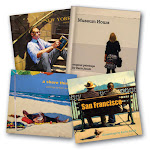6 x 6"
oil on panel
sold
Norman Rockwell's profound 1964 painting 'The Problem We All Live With'
is on the top of my Rockwell list. It depicts 6-year-old Ruby Bridges,
an African-American girl, being escorted to an all-white public school
in New Orleans, by four deputy U.S. marshalls. What is so very
effective is the viewer is seeing the point of view from the angry
crowd, the hint being the racial slurs on the wall and the tomato
splattered in between the figures.
The image was published in a 1964 issue of Look
magazine - Rockwell's contract with the Saturday Evening Post ended in
1963 due to Rockwell's continued frustration with the magazine's
limitations on his expressions of progressive social interests,
including his personal views on civil rights and racial integration.
Norman Rockwell's granddaughter, Abigail, recently wrote a compelling article in the Huffington Post titled
Would There Be Norman Rockwell Without The Saturday Evening Post? Rockwell undoubtedly evolved as an illustrator between 1916 and 196
3 - becoming a storyteller with his images like no other. His career with the
Post yielded 322 covers before he ended his contract.
Ruby Bridges, at the age of 56, visited the painting in the White House in 2011 - at the request of President Obama.
The CNN writer, Bob Greene, wrote about that event in
this article. Within that article, these words struck me "..the message of the painting is so powerful that it goes well beyond
the incident it portrays. The message transcends our usual
Democrats-vs.-Republicans, conservatives-vs.-liberals, left-vs.-right
squabbling. Rockwell was a genius not just because of the
technical skill of his artistry, but because of his eye for the telling
detail. And in "The Problem We All Live With," the key detail is how he
framed the four U.S. marshals who are accompanying that child to school.
We do not see their faces; in the painting, the men are cropped at
their shoulders.
That is the power and the story of the painting:
Four men were accompanying Bridges to school, yes, but the point was,
the United States of America was accompanying her. We see the men's
"Deputy U.S. Marshal" armbands, and that is what matters. The painting
tells us:
This country may have its flaws, but when right and wrong are
on the line, the nation, in the end, usually chooses to stand for right."














